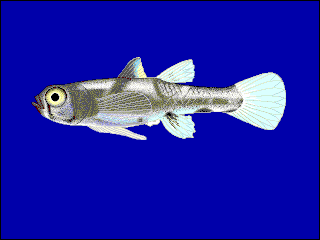Solegnathus is a genus of pipehorse native to the Indian and Pacific Oceans.
Nannoperca or pygmy perch is a genus of temperate perches endemic to freshwater systems of Australia.

The southern little pipehorse is a species of fish in the family Syngnathidae. It is endemic to Australia. Its natural habitats are open seas, shallow seas, subtidal aquatic beds, and coral reefs. It camouflages amongst species of red algae. It is threatened by habitat loss.

Fish are very diverse animals and can be categorised in many ways. Although most fish species have probably been discovered and described, about 250 new ones are still discovered every year. According to FishBase about 34,800 species of fish had been described as of February 2022, which is more than the combined total of all other vertebrate species: mammals, amphibians, reptiles and birds.

The Hippocampinae are a subfamily of small marine fishes in the family Syngnathidae. Depending on the classification system used, it comprises either seahorses and pygmy pipehorses, or only seahorses.
Enneapterygius larsonae, known commonly as the Western Australian black-head triplefin, is a species of triplefin blenny in the genus Enneapterygius. It was described by the German ichthyologist Ronald Fricke in 1994. The specific name honours Helen K. Larson, the Curator of Fishes at the Museum and Art Gallery of the Northern Territory in Darwin, Australia, who collected the type.
Acarobythites larsonae, or Larson's cusk, is a species of viviparous brotula fish only known from reefs off the coast of the Northern Territory, Australia. This species grows to a length of 2.5 centimetres (0.98 in) SL. This species is the only known member of genus Acarobythites. The specific name and common name both honour the curator of fishes at the Museum and Art Gallery of the Northern Territory in Darwin, Northern Territory, Helen Larson who sent speciemsn of fish, especially Ophidiiformes, to the describer Yoshiko Machida for him to study.
Beaglichthys is a genus of viviparous brotulas.

The ribboned pipefish, ribboned pipehorse or ribboned seadragon, is a species of pipefish found along the coast of northern Australia and New Guinea in habitats ranging from shallow and weedy to deeper and sandy bottoms down to depths of 16.5 m (54 ft). This species grows to a total length of 30 cm (12 in). Their colors can range from greenish yellow to brownish red. This species is the only known member of its genus.
Amphelikturus dendriticus, the pipehorse, is a species of pygmy pipehorse native to the western Atlantic Ocean. This small, highly camouflaged pipefish is rarely seen. This species grows to a length of 7.5 centimetres (3.0 in) TL. This species is the only known member of its genus.

The thread pipefish, also known by its Japanese standard name Hari-youji, is a species of pipefish native to the Pacific Ocean around Indonesia, where it is found at depths from 15 to 20 m. This species grows to a length of 2.68 cm (1.06 in), and is the only known member of its genus.

Acentronura gracilissima, the bastard seahorse, is a species of pygmy pipehorse from the coastal waters of Japan and Vietnam, it is expected to occur elsewhere but reports in other areas need to be confirmed. It occurs on rock and algae reefs downto depths of 40 metres (130 ft) where it feeds on mysids, small crabs, fish larvae and probably also on harpacticoid copepods and gammarid shrimps as recorded in other species in the family Syngnathidae. The bastard seahorse is ovoviviparous; the males incubate the eggs in a brood pouch located under the tail.

Acentronura tentaculata, the shortpouch pygmy pipehorse , northern little pipehorse, or dwarf pipehorse, is a species of pygmy pipehorse from the family Syngnathidae. The status of this species is debated and Acentronura breviperula is considered to be subsumed within this species by some authorities. The exact distribution of this species may be as wide as the western Indo-Pacific region from East Africa to New Caledonia and the northern Great Barrier Reef. Other authorities however describe Acentronura tentaculata as being endemic to the Red Sea.

Pandaka is a genus of fish in the goby subfamily, Gobionellinae, native to fresh, brackish and marine waters of Asia and the western Pacific Ocean. Some species in the genus are among the smallest fish in the world; the male P. pygmaea can be just 9 mm (0.35 in) in standard length at maturity.
Trypauchenichthys is a genus of gobies native to fresh, brackish and marine waters along the Indian Ocean and Pacific coasts of Asia.

Acentronura breviperula, also known as the shortpouch pygmy pipehorse, dwarf pipehorse and northern little pipehorse, is a species of pygmy pipehorse, a member of the family Syngnathidae, the seahorses and pipefishes. It occurs in the Indo-Pacific region from the eastern Andaman Sea, through the Malay Archipelago to the Western Pacific as far east as New Guinea and the northern Great Barrier Reef.
Sueviota larsonae, also known as Larson's sueviota, is a species of fish in the family Gobiidae. It is found in the western-central Pacific Ocean.








